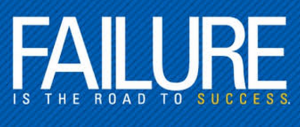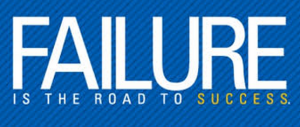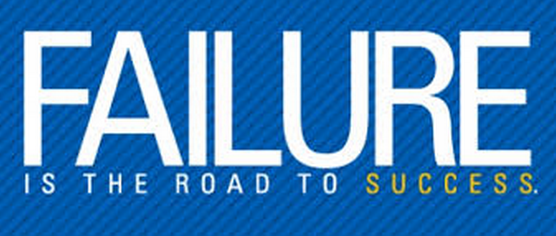Tag: learning
Learning From Mistakes: How Well Do You Learn from Them?
Picasso once said: I am always doing that what which I cannot do, in order that I may learn how to do it. Are you one that likes to do new things in order to learn how to do it … like Pablo Picasso in this quote? Or do you hesitate because of fear of failure? Perhaps you do not realize that your best learning comes from learning from mistakes?

Check out our thoughts on team leverage.
More to learn: The Nine Most Valuable Secrets of Writing Effective Copy
From an early age, we are taught it’s bad to make mistakes and they need to be avoided … otherwise, there can be unpleasant consequences. The truth, however, is that failure and making mistakes is a necessary part of success and it cannot be avoided.
It can only be avoided if you decide to “play it safe” for the rest of your life and if you are happy to remain in your comfort zone and stop expanding and enjoying the exhilarating feeling of continuous growth and development.
But, that’s not really what you want, right?
Failure is a critical part of learning, yet not all of us learn about the importance of failure. There are three kinds of failure, and two of them are good.
Learn the tradeoff between effort and accuracy. In general, the more work you put into any task, the better you will perform it. Put too much work into a task, though, and you have spent valuable time that could have been used elsewhere. So, it is valuable to calibrate the amount of effort a task is worth.
Second, even you put in enough effort, sometimes you still get something wrong. This kind of failure is the best learning opportunity. We need to reward effort. We need to understand that every mistake is a learning opportunity. An error may have immediate consequences, but that does not mean that they cannot learn from that error. The most successful people are not the ones who never fail, they are the ones who learn most effectively from their failures.
Third, there is negligence. Some people consistently fail to put in any significant effort on their work. Negligence is a bad kind of failure because these mistakes are not ones that we can learn from. Instead, it prohibits learning of any kind. Negligence is the only kind of failure that is truly unacceptable.
Related: 10 Extraordinary Ways for Learning to Learn
Here is an excellent example:
When author J. K. Rowling addressed the graduating class at Harvard, she didn’t focus on success. Instead, she spoke about failure. She related a story about a young woman who gave up her dream of writing novels to study something more practical.
Nonetheless, she ended up as an unemployed single mom “as poor as it is possible to be in modern Britain without being homeless.” But during this rock-bottom time, she realized she still had a wonderful daughter, an old typewriter, and an idea that would become the foundation for rebuilding her life. Perhaps you’ve heard of Harry Potter?
“You might never fail on the scale I did,” Rowling told that privileged audience. “But it is impossible to live without failing at something unless you live so cautiously that you might as well not have lived at all—in which case, you fail by default.
So here are three good reasons for why failing is a good thing:

Learning from mistakes … no mistakes /no learning
If you are not failing, you are not learning.
Take a good look at these 2 columns of words.
It’s as if, in those few seconds, your memory skills suddenly sharpened. When you encountered the words with blank spaces, something both imperceptible and profound happened. You stopped. You stumbled ever so briefly, then figured it out. You experienced a microsecond of struggle, and that microsecond made all the difference. You didn’t practice harder when you looked at column B. You practiced deeper.
Deep practice is built on a paradox: struggling in certain targeted ways – operating at the edges of your ability, where you make mistakes – makes you smarter.
Learning from mistakes examples … growth mindset
The concept is a growth mindset versus a fixed mindset. With a growth mindset, people believe anyone can master anything as long as they work hard enough. With a fixed mindset, people believe talent comes from ingrained ability.
It is interesting to note that both mindsets can be changed by six simple words. Half of a set of kids were praised for their intelligence (“You must be smart at this”), and half were praised for their effort (“You must have worked really hard”).
The praised-for-effort group improved their initial score by 30 percent, while the praised-for-intelligence group’s score declined by 20 percent. All because of six short words.
Response to an academic failure – a poor test grade in a new course. Those with the growth mindset said they would study harder for the next test. Those with the fixed mindset said they would study less for the next test. If you don’t have the ability, why waste your time? Which group do you want to be in?
Learning from failure and experimentation
Try many solution options and learn from them all. Never rely on just one approach. The thing is that there is no such thing as a failure … consider all alternatives as experiments.
Capture failure and turn it into skill. The trick is to choose a goal just beyond your present abilities. With experimentation, it is not what you look for that matters, but what you find. With experimentation, it is a lot about learning and failure.
Let us share with you a great story to illustrate what we mean. It is about a pottery class and building the perfect piece of pottery.
There once was a potter who was teaching pottery making to a class of 20 students. As an experiment, the potter split the class into 2 groups, giving each group a simple yet different objective. His hope was to teach his class something about learning and its relationship to creativity and failure.
For group 1, the objective he gave was for each student to make one perfect pot.
For group 2, his objective was for each student to use up 100 lbs of clay.
The first group struggled, working on one pot days on end. Most failed to get it right.
The second group went through a lot of clay and experimented and failed often. But through failure they also iterated, learned, and perfected technique. By the end most had several perfect pots.
The bottom line
There are two important lessons from this experiment.
First, it is important to consider the enablers of the (sometimes hidden) motivation that you employ.
Second, is the importance of not being concerned with failure (i.e. the importance of failing as a means of learning a new skill).
What do you think about this experiment in learning, motivation, and failure? Were the experiment results what you expected?
So what’s the conclusion? The conclusion is there is no conclusion. There is only the next step. And that next step is completely up to you.
It’s up to you to keep improving your ability in learning to learn. Lessons are all around you. In many situations, your competitor may be providing the ideas and or inspiration. But the key is in knowing that it is within you already.
It’s up to you to keep improving your continuous learning from all around in your environment.
All you get is what you bring to the fight. And that fight gets better every day you learn and apply new lessons.
When things go wrong, what’s most important is your next step.
Try. Learn. Improve. Repeat.
Are you devoting enough energy continually improving your continuous learning?
Do you have a lesson about making your learning better you can share with this community? Have any questions or comments to add in the section below?
Mike Schoultz is the founder of Digital Spark Marketing, a digital marketing and customer service agency. With 40 years of business experience, he blogs on topics that relate to improving the performance of your business. Find them on G+, Twitter, and LinkedIn.
Digital Spark Marketing will stretch your thinking and your ability to adapt to change. We also provide some fun and inspiration along the way. Call us for a free quote today. You will be amazed at how reasonable we will be.
More reading on learning from Digital Spark Marketing’s Library:
The Nine Most Valuable Secrets of Writing Effective Copy
10 Extraordinary Ways for Learning to Learn
Continuous Learning Holds the Keys to Your Future Success
Like this short blog? Follow Digital Spark Marketing on LinkedIn or add us to your circles for 3-4 short, interesting blogs, stories per week.
Learning Creativity, Change, and Our Education System
Have you ever done any reading about learning creativity or ways to improve our educational system?

Unless you walk out into the unknown, the odds of making a profound difference are pretty low.
– Tom Peters
One of the outside interests of this agency is learning creativity. We want to start this article with a very creative 3-minute video done by a young student. His subject? The need for change in our education system.
http://www.youtube.com/watch?v=KwYSMwrAczo
We are ones that believe that not enough is being done to increase the learning of creativity in our schools. So, therefore, we like to read and engage in discussions on ideas on learning reform and creativity in our schools.
Change and learning creativity.
Banks used to open and operate between 10 and 3. Now, who can bank between 10 and 3? The unemployed. They don’t need banks. They got no money in the banks.
Who created that business model? And it went on for decades. You know why? Because the banks didn’t care. It wasn’t about the customers. It was about banks. They created something that worked for them. How could you go to the bank when you were at work?
It didn’t matter. And they don’t care whether or not a customer was upset he couldn’t go to the bank. Go find another bank. Yes and they all operate the same way, eh?
Now, one day, some crazy banker had an idea. Maybe they should keep the bank open when people come home from work. They might like that. What about a Saturday? What about introducing new technology?
And so technology can contribute to change. Things can change. Yet not in education. Not even with the introduction of technology. Why?
Poor kids lose ground in the summertime. The system decides you can’t run schools in the summer. Why?
You know, I always wonder, who makes up these rules? Did we ever do it? Well, it just turns out in the 1840s we did have, schools that were open all year. They were open all year because we had a lot of folks who had to work all day. They didn’t have any place for their kids to go. It was a perfect place to have year-round schools. So this is not something that is ordained from the education gods.
So why don’t we?
Educators and those who want to contribute, there’s some stuff we can do. And we’ve got to do better. We have to start with kids earlier, we have to make sure that we provide support to young people. We have got to try new things much more often. We’ve got to be creative and we have to let the students be creative to learn creativity. We’ve got to give them all of these opportunities.
Here is another short 2-minute video we would like to share. It is about the next generation learning in our education system. Also done by children. Even younger.
http://www.youtube.com/watch?v=v0pZE8WW_Ro&feature=youtu.be
Kids bring to the curriculum vast differences – differences in gender, maturity, personality, interests, hopes, dreams, abilities, life experiences, situation, family, peers, language, ethnicity, social class, culture, probable and possible futures, and certain indefinable qualities, all combined in dynamic, continuously evolving ways so complex they lie beyond ordinary understanding.
Today’s reformers seem unable or unwilling to grasp the instructional implications of those differences and that complexity. They treat kids as a given, undifferentiated except by grade level, with the core curriculum the lone operative variable.
It’s dumping creativity on the street.
So here is the thing. Our students recognize the problem. Why can’t education leaders?
Remember … we can truly understand facts about learning only in contrast to other facts.
Like this short blog? Follow Digital Spark Marketing on LinkedIn or add us for 3-4 short, interesting blogs, stories per week.
Read more from Digital Spark Marketing’s blog library:
Aware of These Amazing Facts on Innovation?
Can Prototype Testing Help You Experiment With New Ideas?
Creative Collaboration is the Solution for the Toughest Business Problems
Success Enablers of Highly Creative Leaders
Do you often follow your intuition? Do you consider it a success enabler of highly creative leaders? Let’s investigate what these success enablers are especially for highly creative leaders.

There is a wide consensus in industry and academia that creativity is a key requisite to master today’s business challenges. A recent CEO survey by IBM showed that creativity is the number one requirement of today’s managers for the next years to come. To be creative under time pressure, however, is not an easy task. Ideas are often the result of insights or come about through the long incubation and development of dispersed insights.
Yet in business contexts, idea generation must work ad-hoc, on-demand, and often in group contexts. These are diverse and distributed knowledge is needed to solve problems creatively.
Related: The Zen of Abraham Lincoln’s Leadership Lessons
To facilitate such instant creative idea sessions, various creativity techniques have been developed over the last decades. These techniques are supposed to help professionals be more creative and generate novel and feasible ideas, either individually or in teams.
Still, numerous scientific evaluations show that the most widely used method in business today, brainstorming, is not necessarily an effective tool. Participants may think too far out of the box so that their ideas cannot really be put to use. These ideas often are not sufficiently related to the problem at hand.
Based on experience we have defined 9 success enablers of highly creative leaders, as discussed below:
Committed senior leadership
Leadership depends on senior leadership for support. Even more so when you add creativity to the equation. This support helps remove barriers to enhance organizational creativity.
While the truly inspired and creative may break through the barriers to success, an environment where help supports organizational creativity may reap benefits. These benefits come from many surprising sources and not just Einstein’s of the world. All leaders own the role to remove barriers.
Building a community
We all need to find people that have common interests and thinking. Connecting to others helps us uncover phenomena, patterns, and solutions more quickly — and in ways, we might not imagine on our own.
Additionally, creative ideas have a difficult time thriving in isolation. Your community can inspire, ask, plant seeds, bear witness, provoke, acknowledge, and nurture — all elements of a collaborative venture.
Our ideas need communities of contributors, and we need each other. The more connections we have, the more powerful our creativity becomes. Building communities is a critical success enabler.
Highly creative leaders and curiosity
Curiosity is the cornerstone of learning and creativity. Hands down the most important to creativity in our opinion. Think about answering these curiosity enablers:
When did we stop asking questions? What happens to our habits of inquiry and knowledge-seeking as we get older? What barriers shut down curiosity?
In order to reclaim curiosity as a collaborative habit, you must model the way for others. It’s necessary to embark upon a personal investigation to unravel perceptions and conventions. These get in the way of a curious, open mindset and enable it.
Open communication and information sharing
Open communication and information sharing are another of the essential success enablers. Our understanding of organizational decisions and policies, opportunities to voice concerns, and a sense of ‘being heard’ all enhance leadership creativity.
For me, one of the barriers to creative collaboration in an environment where people undermine each other. Such barriers to information are not shared, and there is no credit given for creativity.
It is essential to have access to information as creativity is often spurred on by hitchhiking. Such information focused on new ideas that flow past the alert mind–often converting them to a new situation or application.

Reflection is always wise.
Reflection
We need leaders to engage in continuous reflection, be aware and open, and challenge their assumptions. And certainly, gain from continuous learning. On a collective level, we want leaders to share and support. These leaders are trusting and are vulnerable as part of a creative journey within a supportive community.
Combine and transform
To be a successful leader and thinker, you need to also be an accomplished learner. By participating in combining and transforming, we must recognize the importance of acknowledging those individuals. These works that have influenced our thinking. And we must learn from them.
Practicing the habit of combining and transforming is about embracing a new form of learning and finding your creative voice. It allows us to form powerful connections with other people and to engage in social learning.
Empowerment
The empowered have much freedom and authority to initiate change. Some gave it to themselves while others waited for it to be given. Often many see the anxiety that at times accompanies empowerment.
Ideally, the empowerment of people results in the increased initiative, involvement, enthusiasm, innovation, and speed.





